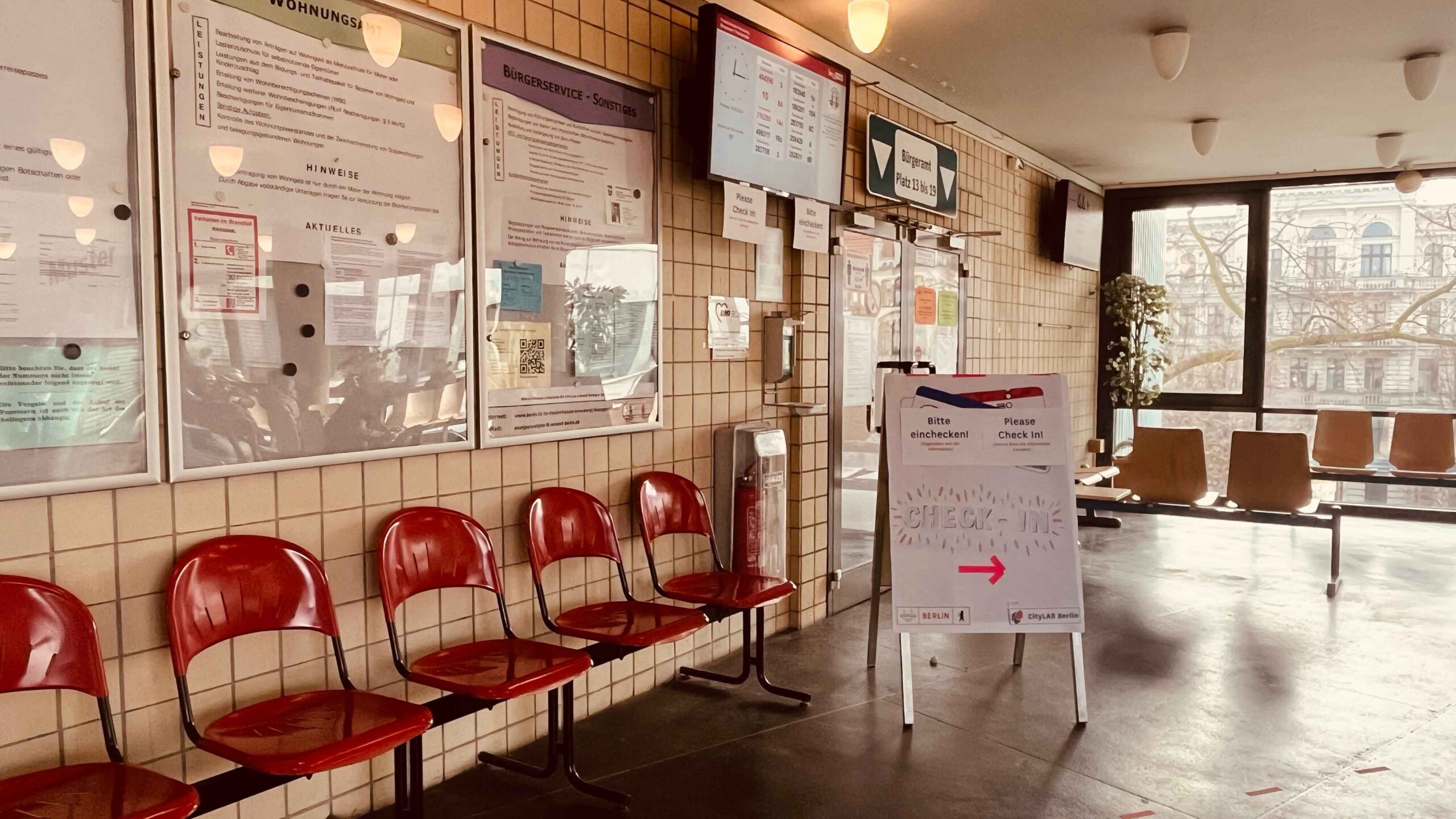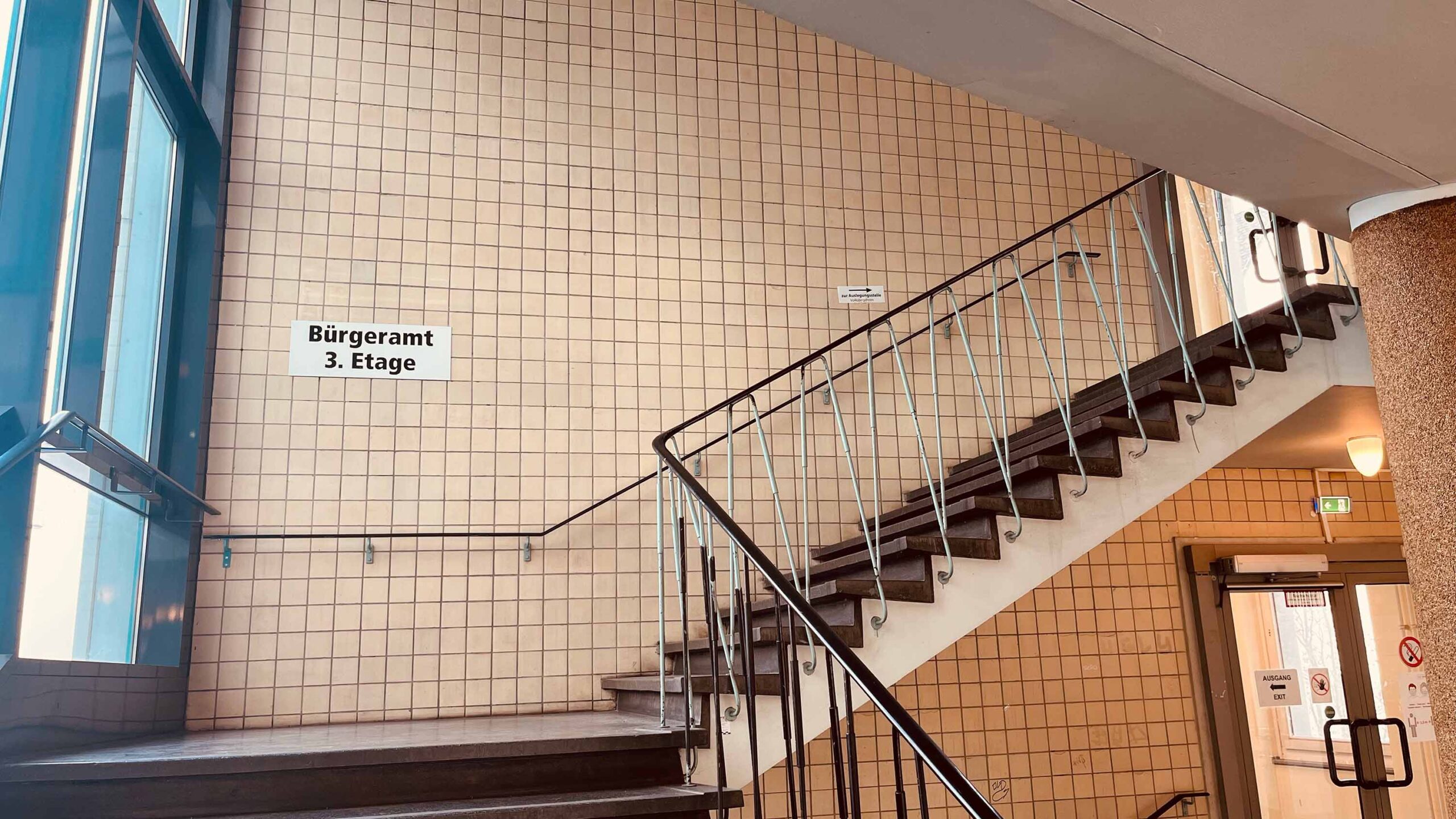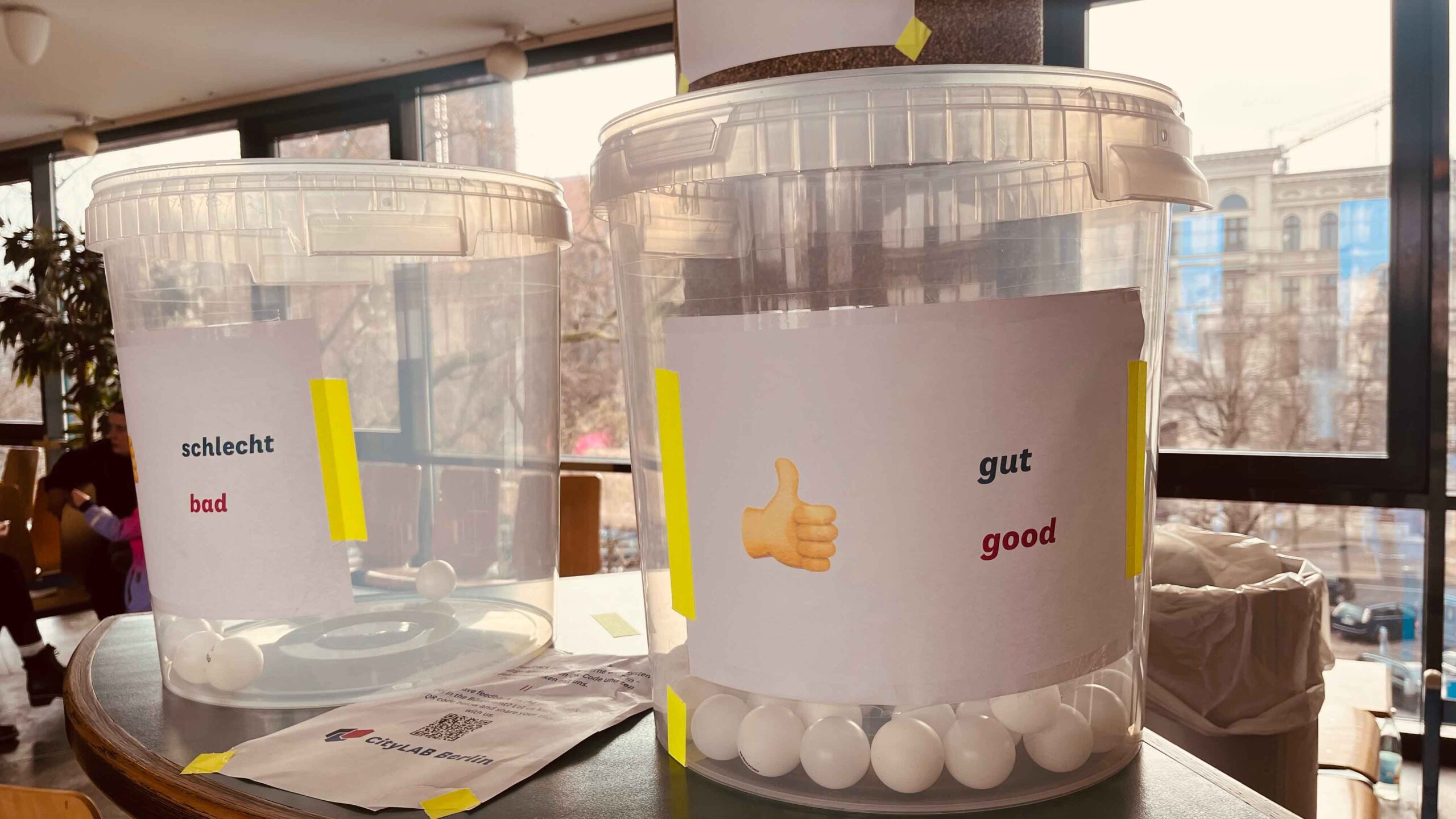What has happened to date
In our project Bürgeramt of the Future we take a close look at the day-to-day work and processes that go on at Berlin’s citizen’s centers in order to identify possible improvements together with the employees and put these to the test right away. One absolutely key question was: which workflows at the citizen center vocational training department might be optimized so as to get closer to achieving the 14-day target – i.e. enabling people to get an appointment at a Berlin citizen center within 14 days?
In the first part of the project at the Friedrichshain-Kreuzberg citizen center vocational training department, we set out to take an in-depth look at this and other questions. Here we got to shadow trainees in their discussions with citizens and even get an insight into their diaries in connection with a survey. By means of direct dialog, we gathered lots of helpful observations and were quickly able to identify a key time-waster at citizen centers: the no-shows. If citizens fail to show up for a booked appointment, the appointment simply passes by unused and can’t be spontaneously rescheduled. A more flexible check-in system could remedy this problem, thereby increasing schedule efficiency – at least that’s the assumption.

We now wanted to explore this idea of a check-in system in more detail together with the Senate Department for the Interior, Digitalization and Sports and the District of Friedrichshain-Kreuzberg: so here comes part 2 of our Bürgeramt of the Future.
From theory to practice: the prototype
The first test run at the citizen center vocational training department
Our aspiration at CityLAB is to subject ideas to real-life testing using a prototype, then analyze the outcomes and improve the system on this basis. So after our exploratory phase in part 1, it was now time to make a prototype out of the idea of a check-in system, developed together with the departmental management at the Friedrichshain-Kreuzberg citizen centers. We wanted to find out how this on-site check-in might look and function in concrete terms – and above all whether both employees and citizens would benefit from it. It quickly emerged that our prototype had to be transferred to a real-life environment, i.e. subjected to day-to-day requirements and conditions. Thanks to the management’s open-minded outlook, we got the chance to try out the prototype at the Friedrichshain-Kreuzberg citizen center vocational training department once again.
The prototype was developed by our team of developers at CityLAB in a two-week sprint. Due to technical constraints, it wasn’t possible to link the prototype directly to the time management system used by the citizen centers, so we decided to use a prototype that works independently. In this way, it was at least possible to apply the prototype parallel to the existing scheduling system.
Before the official start of the three-week test phase, we conducted a pre-test to present the prototype to employees at the citizen center vocational training department and clarify any questions and ambiguities in advance. This pre-test was essential so as to get a sense of the hurdles and challenges that employees already anticipated for the testing phase.
Then the time finally came: clear the decks for the prototype test! We used qualitative and quantitative methods to look at how satisfaction levels developed in both citizens and employees during the test, and we also collected data to evaluate our initial hypothesis.
The result: we received promising feedback on our idea about how to make the arrangement of appointments at citizen centers more efficient and reduce waiting time. All in all, the test at the citizen center vocational training department was extremely positive, and everyone involved felt encouraged to continue to pursue the idea of a check-in system. Over the test period as a whole, we succeeded in increasing the number of appointments by about 10%.
The second test run in day-to-day operations at the citizen center in Yorckstrasse
In order to gather further data and hands-on experience with the prototype, the CityLAB product team then decided to conduct a second test – but this time at an “increased level of difficulty” in the context of real-life, day-to-day operations. A different location was chosen for this: the citizen center in Yorckstrasse – much to the delight of the head of department there, Oliver Kühle: “Fortunately for us, Ralf Kleindiek heard about our first test at the citizen center vocational training department and said he’d like to run another test in the context of day-to-day operations at another citizen center as soon as possible. Since we were involved in supervising the first test, we didn’t want to miss out on that opportunity of course – so we went for it.

While the citizen center vocational training department provided an excellent test environment for the first run, running the test as part of a citizen center’s regular day-to-day operations opens up a whole new range of possibilities. Mr Kühle agreed: “We have a whole different volume of appointments here and different processes, too, so it was fascinating to see whether we could achieve the same outcomes with this test as we did in the training department setting – or whether there would be other things we’d have to consider to integrate the check-in system in regular operations.”
The prototype was tested for more than two weeks at the citizen center in Yorckstrasse. Citizens received several notices informing them about the test when they came into the center, and there were markings to guide them to the check-in. Here they were greeted by staff members and encouraged to officially check in with their appointment number. Each citizen present was registered in the check-in systems so that employees could view from their own desks who was there.
“We have a system whereby we’re supposed to wait two to three minutes after calling someone – we can’t check them off until after that time has passed. But sometimes, someone else will come in seven minutes later who’s got lost. So we can never be quite sure whether the right person is there or not. As such, I do think the check-in system is helpful here.”
An employee at the Bürgeramt
The test was run on Mondays, Wednesdays and Fridays, as these are usually the days with fewer appointments. This alternating scheme benefited employees, too, as it meant that their normal rhythm at the center was not permanently disrupted. Department head Kühle was enthusiastic about the atmosphere during the test: “The beauty of the whole project is that we can just try things out. Here we have the opportunity to test things using a prototype right away – on both citizens and employees.”
The evaluation of the test run in a day-to-day context
The second test also went well overall: once again, the new check-in system received predominantly positive ratings from staff on site and from citizens; the latter had the chance to rate the system in the entrance area of the citizen center by means of a query system using ping-pong balls.

When it came to the analysis, we were particularly interested in how employees experienced the whole thing. In addition to employee diaries, we asked Mr Kühle to tell us about the mood in the team in more detail: “On the first run-through when we tested on the trainees, we had 100 per cent approval for the test. At the citizen center here in Yorckstrasse, our staff are far more diverse in terms of age. So here the response to the test run was much more varied. A little over half were very open-minded and liked it, the other half were quite skeptical – not about the check-in system as such, but more about whether the whole thing would work in a real-life context.”
One hurdle in the workflow remained the combined use of the internal appointment management system and our prototype. This was something an employee confirmed to us as well: “Technically speaking, the check-in wasn’t difficult to use. The main problem derived from the fact that we had to use two programs side by side – i.e. our own time management system and the check-in system, since the two programs are not interlinked. So if you get your digits mixed up when you check the ticket number, it might mean you can’t find the person, and that can be an additional burden.”
Another challenge was the size of the waiting room: during the test, we had to adjust our signage several times so that citizens would notice the check-in system and use it instead of sitting down right away as usual and waiting for their number to be called. Mr Kühle also emphasized this hurdle: “We have rather a cluttered entry zone, so citizens do tend to get lost now and then. During the test, we had to speak to these individuals in person and guide them to the check-in. That needs to be different in the future – we need an entrance zone where people are clearly directed to the check-in.”

Despite the additional work involved, the response was positive overall:
“Of course, the testing days were more intense and initially caused extra work for our employees, too. But the citizens’ response was helpful – many welcomed the opportunity to sign up, and our employees realized their efforts were being positively received. That’s ultimately better for everyone involved.”
Head of department Oliver Kühle
What comes next?
In terms of continuing to pursue the check-in system – and indeed other future projects – there’s a lot we’ve been able to take away from the process involving multiple tests. These were our three main findings:
- Open-ended approaches help make room for innovation.
- There are no shortcuts: first you have to develop a proper understanding of the problem, only then can you start to look for solutions.
- An interactive approach to work pays off: not everything has to go perfectly. It’s crucial for us to learn from experience and incorporate what we’ve learned into the overall process.
At the beginning of March we’ll be coordinating the next steps for further implementation of the check-in system together with the department management at the Friedrichshain-Kreuzberg citizen centers and the Senate Department for the Interior, Digital Affairs and Sports. Our aim is to go on testing the check-in system in regular day-to-day operations and be able to hand over a fully developed system when the time is ripe so that this idea can perhaps one day help make the work of staff at citizen centers a little easier and provide the citizens of this city with a more flexible appointment system.
In doing so, we look forward to engaging in further cooperation, as do our partners at the Friedrichshain-Kreuzberg citizen centers: “Working with CityLAB was a very positive experience,” said Mr Kühle at the end. “For us, CityLAB is a great partner to be involved with because we feel we’re working towards the same things: we have the same desire to try things out, and the same commitment to making things better for everyone – not just for citizens, but for employees, too – with the aim of reforming Berlin’s administration a little bit in the process.”
This is something we’re very much looking forward to as well, so we’re already very excited to see what the next steps will be towards the Bürgeramt of the Future!
